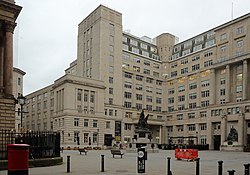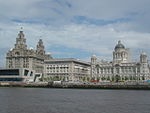Exchange Flags
| Exchange Flags | |
|---|---|
 | |
 | |
| Alternative names |
|
| General information | |
| Type | Commercial offices, museum & restaurants & bars |
| Architectural style | Stripped classical |
| Location | Liverpool, England, United Kingdom |
| Completed | 1939 |
| Owner | Ashtrom |
| Design and construction | |
| Architect(s) | Gunton and Gunton |
| References | |
| [1] | |
Exchange Flags is a Grade II listed building in Liverpool, England. It is laid out in a 'U' shape, with Walker House situated on the west side and Horton House on the east side. Walker House (formerly known as Derby House) was adapted during its construction to include a reinforced bunker that housed the Western Approaches Command Headquarters, the command centre for the campaign waged against the German submarine fleet during the Second World War. The courtyard faces Liverpool Town Hall and contains the Nelson Monument.
History
[edit]The current buildings sit on the same site of two previous exchanges in Liverpool:
The building has eleven storeys and has a combination of flat and mansard roofs. Construction of the main building was completed in 1939 but the construction of Walker House was interrupted by the war. The inclusion of the reinforced bunker to house the command centre for the Battle of the Atlantic meant that Walker House wasn't finished until 1941. The two storey underground bunker covers an area of 55,000 square feet (5,100 m2) and had a staff of over 1,00 Royal Air Force and Royal Navy personnel.[2] Ventilation to the bunker was provided via a ventilation shaft that was built into the Nelson Monument.[3] The bunker was closed on 15 August 1945 after the end of the war but was re-opened in 1993 as the Western Approaches Museum.[4][5]
Horton House was not completed until 1955 and is named after Admiral Sir Max Horton who was commander-in-chief of the Western Approaches during the war.[6]
The site was purchased in the late 1980s by Liverpool businessman Bill Davies, the former owner of Aintree Racecourse. The building was left largely empty until it was sold in two separate deals in 2006 and 2007. Shelbourne Asset Management bought the site in 2017 for £42m and sold it to its current owners, Ashtrom, for £68m in August 2019.[7]
See also
[edit]Notes
[edit]References
[edit]- ^ England. "EXCHANGE BUILDINGS - 1245031 | Historic England". Historic England. Retrieved 21 November 2016.
- ^ "About Western Approaches – Western Approaches". Retrieved 13 February 2023.
- ^ Williams, Olivia (11 February 2023). "Secret feature of statue hundreds of people walk by everyday". Liverpool Echo. Retrieved 13 February 2023.
- ^ "Western Approaches History". Liverpool War Museum. Retrieved 22 November 2016.
- ^ "About Western Approaches – Western Approaches". Retrieved 13 February 2023.
- ^ Chalmers, W.S. (1954). Max Horton and the Western Approaches, A biography of Admiral Sir Max Kennedy Horton, G.C.B., D.S.O. London: Hodder and Stoughton. p. 3.
- ^ "Liverpool city centre office complex changes hands for £68m". Liverpool Business News. 1 August 2019. Retrieved 5 August 2019.





